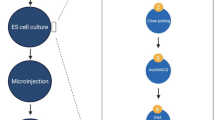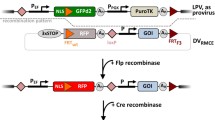Abstract
The generation of transgenic animals with a gain-of-function mutation is commonly achieved by procedures based on random DNA integration. The resulting transgenic founder lines are unique, not reproducible and have variable expression patterns. In contrast, the targeted integration of transgenes into a predetermined neutral genomic position solves most of the inadequacies of random integration methods. However, homologous recombination (HR) in mouse embryonic stem cells (ESCs) currently requires careful design of the targeting vector and a laborious procedure to identify clones with the correct insertion event. Here, we introduce a feasible strategy that employs a heterozygous double fluorescent reporter ESC line for simple identification of a knock-in HR event via detection of endogenous fluorescence expression. Following positive selection using antibiotics, the system offers a second selection step to identify targeted clones by the loss of one of two fluorescence reporters in lieu of the time consuming Southern blotting and PCR analysis routinely applied in conventional targeting experiments. Moreover, the method allows for the simple detection of chimerism (negating the need for appropriate coat colour combinations) and enables the early detection of germline transmission by fluorescence reporter expression in F1 neonates.



Similar content being viewed by others
References
Agulnik AI, Bishop CE, Lerner JL, Agulnik SI, Solovyev VV (1997) Analysis of mutation rates in the SMCY/SMCX genes shows that mammalian evolution is male driven. Mamm Genome 8:134–138
Cui CQ, Wani MA, Wight D, Kopchick J, Stambrook PJ (1994) Reporter genes in transgenic mice. Transgenic Res 3:182–194
Deng C, Capecchi MR (1992) Reexamination of gene targeting frequency as a function of the extent of homology between the targeting vector and the target locus. Mol Cell Biol 12:3365–3371
DiLella AG, Hope DA, Chen H, Trumbauer M, Schwartz RJ, Smith RG (1988) Utility of firefly luciferase as a reporter gene for promoter activity in transgenic mice. Nucleic Acids Res 16:4159
Doetschman T, Gregg RG, Maeda N, Hooper ML, Melton DW, Thompson S, Smithies O (1987) Targeted correction of a mutant hprt gene in mouse embryonic stem-cells. Nature 330:576–578
Hasty P, Rivera-Perez J, Bradley A (1991) The length of homology required for gene targeting in embryonic stem cells. Mol Cell Biol 11:5586–5591
Jagle U, Gasser JA, Muller M, Kinzel B (2007) Conditional transgene expression mediated by the mouse beta-actin locus. Genesis 45:659–666
Lobe CG, Koop KE, Kreppner W, Lomeli H, Gertsenstein M, Nagy A (1999) Z/AP, a double reporter for cre-mediated recombination. Dev Biol 208:281–292
Mansour SL, Thomas KR, Capecchi MR (1988) Disruption of the proto-oncogene Int-2 in mouse embryo-derived stem-cells—a general strategy for targeting mutations to non-selectable genes. Nature 336:348–352
McCreath KJ, Howcroft J, Campbell KH, Colman A, Schnieke AE, Kind AJ (2000) Production of gene-targeted sheep by nuclear transfer from cultured somatic cells. Nature 405:1066–1069
Novak A, Guo C, Yang W, Nagy A, Lobe CG (2000) Z/EG, a double reporter mouse line that expresses enhanced green fluorescent protein upon Cre-mediated excision. Genesis 28:147–155
Shu X, Royant A, Lin MZ, Aguilera TA, Lev-Ram V, Steinbach PA, Tsien RY (2009) Mammalian expression of infrared fluorescent proteins engineered from a bacterial phytochrome. Science 324:804–807
Silva AJ, Simpson EM, Takahashi JS, Lipp HP, Nakanishi S, Wehner JM, Giese KP, Tully T, Chapman PF, Abel T, Fox K, Seth G, Itohara S, Lathe R, Mayford M, McNamara JO, Morris RJ, Picciotto M, Roder J, Shin HS, Slesinger PA, Storm DR, Stryker MP, Tonegawa S, Wang Y, Wolfer DP (1997) Mutant mice and neuroscience: recommendations concerning genetic background. Neuron 19:755–779
Soriano P (1999) Generalized lacZ expression with the ROSA26 Cre reporter strain. Nat Genet 21:70–71
Srinivas S, Watanabe T, Lin CS, William CM, Tanabe Y, Jessell TM, Costantini F (2001) Cre reporter strains produced by targeted insertion of EYFP and ECFP into the ROSA26 locus. BMC Dev Biol 1:4
Thomas KR, Capecchi MR (1987) Site-directed mutagenesis by gene targeting in mouse embryo-derived stem-cells. Cell 51:503–512
Vintersten K, Monetti C, Gertsenstein M, Zhang P, Laszlo L, Biechele S, Nagy A (2004) Mouse in red: red fluorescent protein expression in mouse ES cells, embryos, and adult animals. Genesis 40:241–246
Yagi T, Nada S, Watanabe N, Tamemoto H, Kohmura N, Ikawa Y, Aizawa S (1993) A novel negative selection for homologous recombinants using diphtheria toxin A fragment gene. Anal Biochem 214:77–86
Ying QL, Wray J, Nichols J, Batlle-Morera L, Doble B, Woodgett J, Cohen P, Smith A (2008) The ground state of embryonic stem cell self-renewal. Nature 453:519–523
Acknowledgments
The authors wish to acknowledge Tien Yin Yau for editing the manuscript, Nicole R. Leitner for helpful discussions and Gudrun Koch for the excellent support with the figure set up. This work was supported by GEN-AU III Austromouse to TR.
Author information
Authors and Affiliations
Corresponding author
Electronic supplementary material
Below is the link to the electronic supplementary material.
Rights and permissions
About this article
Cite this article
Kautschitsch, S., Andersen, L., Hammerschmid, S. et al. Rapid identification of targeted transgene integrations in ES cells by fluorescence detection. Transgenic Res 23, 469–475 (2014). https://doi.org/10.1007/s11248-014-9782-3
Received:
Accepted:
Published:
Issue Date:
DOI: https://doi.org/10.1007/s11248-014-9782-3




